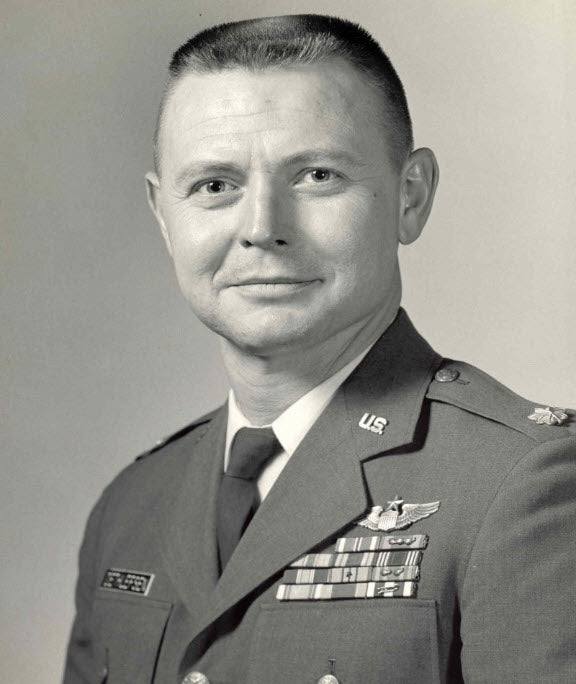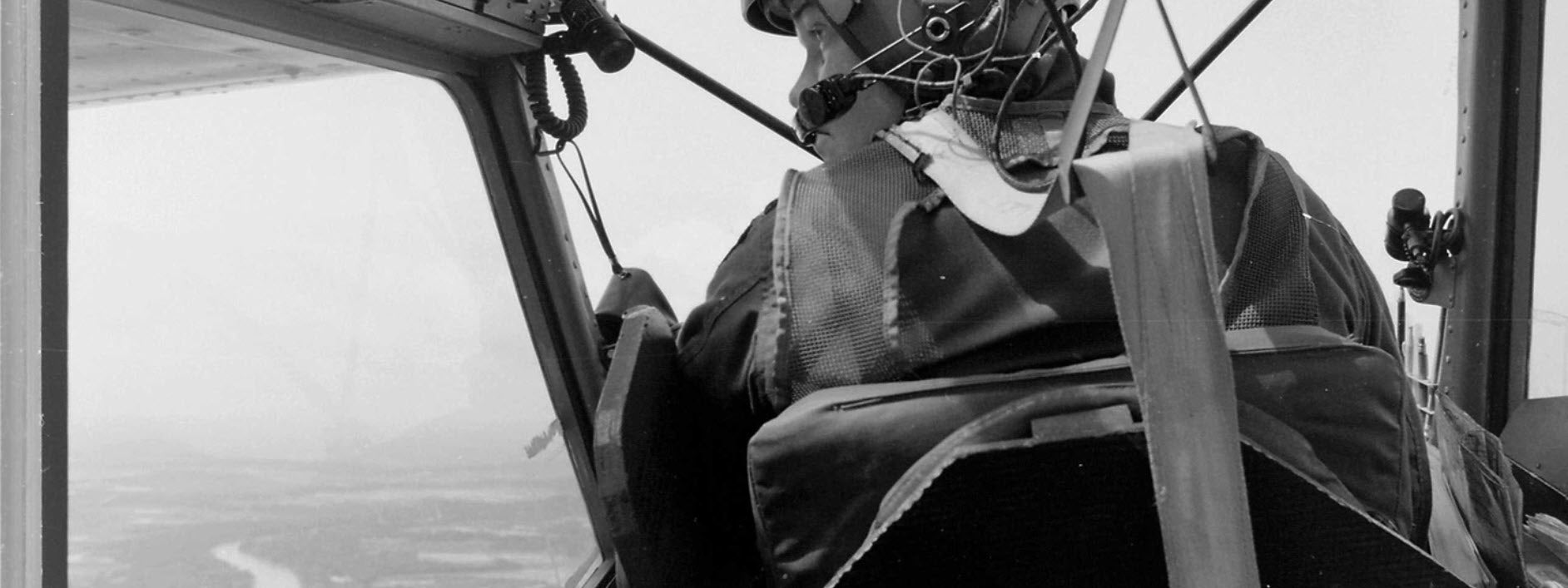The Wild Weasel III

Republic F-105G Thunderchief at the National Museum of the United States Air Force.
The Republic Aircraft Company designed and built the F-105 Thunderchief as single-engine single-seat jet fighter-bomber in 1955. It was designed to be a nuclear strike fighter bomber withlimited capability for air-to-air combat.
Over the years 833 of these aircraft were built in several different models, including the two-seat Wild Weasel versions.
This was a large single-engine aircraft for a fighter. It weighed over 25 tons with a full load of ordinance on the airplane, which earned it the name "lead sled" by the pilots who flew it.
In fact, the F-105's internal bomb bay is as large as that of the WW Two B-17!
Republic modified the original F-105 Thunderchief into a two-seat aircraft to accomodate a pilot and an electronic warfare officer, known as a "bear."
This aircraft was then named Wild Weasel III
The History of Wild Weasels
Wild Weasel was a code named given by the USAF to an aircraft of any type equiped with anti-radiation missiles and tasked with suppressing enemy air defense systems.
The job of a Wild Weasel aircraft is to bait enemy anti-aircraft air defense systems into targeting the Weasel with their radars, whereupon the radar signal is traced back to it's source which then allows the Weasel aircraft to precisely target the site for destruction.
The concept of the Wild Weasel was developed by the US Air Force in 1965 during the Vietnam War.
Initially the Wild Weasel I was an F-100 Super Sabre jet, but it did not have the performance characteristics to survive in a high threat environment.
The initial squadron of F-100 Wild Weasel Is had 8 aircraft and 16 crew members. After 45 days of operatons only one aircraft was left with four crew members killed, two were prisoners of war, three had been wounded, and two quit.
Next came the Wild Weasel II, an F-4C Phantom, which again failed, followed by the Wild Weasel III, the Republic F-105 in the summer of 1966.
Later, when the Air Force ran out of F-105G aircraft (production had stopped in 1964), they turned to the F-4C Phantom II (the Wild Weasel IV), and then to the Phantom F-4E and F-4G aircraft (the Wild Weasel V).
For todays post we are looking at the Wild Weasel III, the Republic F-105G Thunderchief.
The first Wild Weasel success came on December 29, 1965 during Operation Rolling Thunder when they struck the railyard at Yen Bai, some 75 miles NW of Hanoi.
Hanoi, North Vietnam
During the Vietnam War the capital of North Vietnam was Hanoi, a city with a population of approximately 500,000.
At the time Hanoi was known for having the greatest concentration of anti-aircraft weapons in the world. This made attacking anything within the area of Hanoi one of the most dangerous places in the world.
The role of the Wild Weasels was to take out as many of these defensive weapons just before regular F-105 "Thuds" would arrive over the target, drop their bombs, and then exit the area as quickly as humanly possible.
The Wild Weasel aircraft and crew were well suited for this mission. The airplane carried sophisticated electronic gear and weapons to locate and destroy enemy SAM (surface-to-air missile) and AAA (anti-aircraft artillery) sites.
The "bear" in the backseat would use his electronic sensors to locate active hostile radar signals and fire radar homing air to ground missles at the target.
The hostile radar signals had a sound similar to the sound of a rattlesnake along with a bright blip on the bear's radar screen.
However, the North Vietnamese learned quickly to send all the electronic indication of a SAM launch without actually launching the SAM missle!
As a result, the bear's radar scope became cluttered with lots of threat indications making the crew never sure when and where the next real SAM launch would happen.
So, as usual in aviation, it was up to the pilot and his rear-seater to scan the horizon in all directions and see if they could find any of the deadly "telepone poles" (SAMs) rising to meet them.
Once spotted the pilot would put the aircraft into violent manuevers to evade the SAM!
The greatest fear was that a SAM fired from directly behind and striking the aircraft with a lethal blast.
Suppressing flak and SAMs was inherently dangerous, but important to force the enemy flak gunners and SAM missle crews to commit to going after the Weasels and allow the fighter-bombers to drop their bombs on the target!
Of course, there were also the MIG intercepters lurking nearby just waiting for the chance to sneak in undetected and rip the Weasel apart with air-to-air missles or cannon fire!
The Wild Weasel crews earned the respect of their fellow pilots flying the regular F-105 Thuds.
In the north every valuable target was defended by lots of flak and SAM sites, which meant the Wild Weasels were constantly in danger while attacking those sites.
First In, Last Out: Wild Weasels vs SAMs
After the start of Operation Rolling Thunder in March 1965, the communists began building SA-2 SAM sites in North Vietnam. The United States first became aware of the SA-2 in the mid-1950s, but it still had no specialized tactics to destroy it.

North Vietnamese SAM crew in front of SA-2 launcher.
Moreover, U.S. policy in Southeast Asia greatly complicated the problem. North Vietnamese SAM sites were initially off limits for attack, primarily because of fears of escalating the war if the Soviet technicians who built and helped operate these sites were killed.
Some also naively thought that the North Vietnamese would not fire the SA-2s if the United States left the sites alone.
On July 24, 1965, an SA-2 shot down a USAF F-4C, the first of 110 USAF aircraft lost to SAMs in Southeast Asia. Even after the initial losses to SAMs, the USAF could not destroy the SA-2 missiles wholesale in their sanctuary storage sites in Hanoi and Haiphong.
Rather, they were forced to attack the active sites virtually one at a time, a particularly inefficient and dangerous method.
SA-2s also caused other serious problems.
While flying low to avoid SAMs, aircraft were more vulnerable to deadly antiaircraft artillery fire (AAA) -- in fact, AAA downed two-thirds of U.S. aircraft lost in Southeast Asia.
Even if they did not down an aircraft, SA-2s forced strike aircraft to jettison their bombs early or drop them inaccurately.
Three days after the first shoot down from an SA-2 over North Vietnam, the USAF attacked two SAM sites.
Of the 46 F-105s in the strike, six aircraft were shot down and many more were damaged by AAA.
Moreover, it turned out that both sites were abandoned (the enemy had moved the missiles and radars to other sites).
Other conventional anti-SAM attacks fared little better -- some answer to the SA-2 was desperately needed.
The Aircraft

A flight of four F-105 Wild Weasel III aircraft fully armed and ready for action.
The Republic F-105 Thundercheif was the first supersonic tactical figher-bomber developed from scratch.
Apart from being the biggest single-seat, single-engine combat aircraft in history, the F-105 was notable for its large internal bomb bay and unique swept-forward engine inlets in the wing roots.
The wing was highly swept and incorporated low-speed ailerons and high-speed spoilers for lateral control, and a droop-snoot leading edge.
Specifications:
- Wing Span: 34 feet 11 inches;
- Length: 67 feet;
- Height: 20 feet 2 inches;
- Maximum Speed: 831 mph;
- Cruise Speed: 596 mph;
- Range: 1,500 miles;
- Service Ceiling: 50,000 feet;
- Armament: One M6-1 20mm Vulcan cannon plus 14,000 pounds of ordinance including conventional bombs, rocket packs, missiles, and internally or externally carried special weapons.
The F-105G Wild Weasel used the AGM-45 Shrike anti-radiation missle to take out the North Vietnamese SAM and flak sites.

The AGM-45 Shrike Anti-Radar Missile on display in the First In, Last Out - Wild Weasels vs. SAMs exhibit
I hope you enjoyed this trip through some of the history of aviation. If you enjoyed this trip, and are new to this newsletter, sign up to receive your own weekly newsletter here: Subscribe here!
Until next time, keep your eyes safe and focused on what's ahead of you, Hersch!







Leave a comment
This site is protected by hCaptcha and the hCaptcha Privacy Policy and Terms of Service apply.